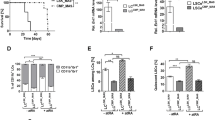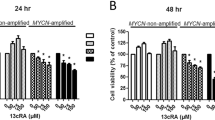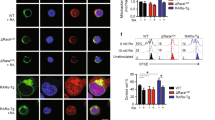Abstract
Retinoids and vitamin D (VD) cooperate to induce the differentiation and inhibit the proliferation of human myelomonocytic leukemia cells. Two classes of retinoids receptors, the RARs and RXRs, respectively, can mediate these effects. RXR forms heterodimers with a variety of nuclear receptors, including RAR and the VD receptor. We have previously found that VD treatment increases RXRα levels in myelomonocytic leukemia cells. By immunoanalysis, we observed in the present work that the RARα protein is expressed in proliferating U937, HL-60 and THP-1 human leukemia cells and that VD treatment induces alterations of its electrophoretic pattern, although with large differences between cell lines. In the three cell lines, 9-cis RA, an agonist of both RARs and RXRs, cooperated with VD more efficiently than all-trans RA and RAR-specific synthetic ligands, thus suggesting an involvement of both RAR and RXR pathways in cell differentiation. Using U937 cells as a model, we delineated the relative contributions of RAR and RXR by assessing the effects of receptor-selective synthetic retinoids. The synergy between VD and all-trans RA or RAR-specific agonists (TTNPB and Ro 40-6055) was abrogated by a RARα-specific antagonist (Ro 41-5253), confirming an involvement of RARα. However, the cooperation between VD and 9-cis RA, although reduced, was not suppressed by the antagonist, suggesting also an involvement of the RXR pathway. The role of RXR as a ligand-activated receptor was confirmed using RXR-specific agonists (CD2608 and LGD1069), which also proved able to cooperate with VD. Finally, while each synthetic agonist alone was significantly less potent than 9-cis RA, combinations of the RAR and RXR selective agonists TTNPB and LGD1069 appeared to be as effective as the pan agonist 9-cis-RA. These results confirm that various retinoids can cooperate with VD and demonstrate that, at a whole cell level, optimal effects require the activation of both RAR and RXR receptors.
This is a preview of subscription content, access via your institution
Access options
Subscribe to this journal
Receive 12 print issues and online access
$259.00 per year
only $21.58 per issue
Buy this article
- Purchase on Springer Link
- Instant access to full article PDF
Prices may be subject to local taxes which are calculated during checkout
Similar content being viewed by others
Author information
Authors and Affiliations
Rights and permissions
About this article
Cite this article
Defacque, H., Sévilla, C., Piquemal, D. et al. Potentiation of VD-induced monocytic leukemia cell differentiation by retinoids involves both RAR and RXR signaling pathways. Leukemia 11, 221–227 (1997). https://doi.org/10.1038/sj.leu.2400568
Received:
Accepted:
Issue Date:
DOI: https://doi.org/10.1038/sj.leu.2400568



